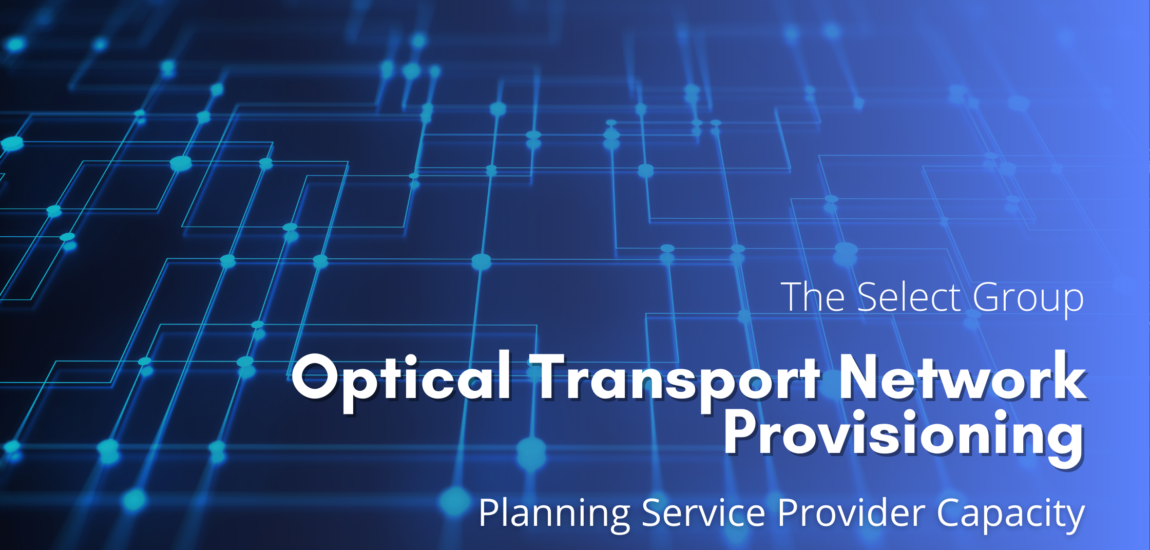Optical Transport Network
Provisioning

Planning Service Provider Capacity
The explosion of 5G, Cloud, IoT, Artificial Intelligence (AI), Machine Learning and the growing array of bandwidth-hungry applications have become ever more reliant on higher speed fiber optic connections traversing an increasingly diverse geographic environment.
Optical Transport Network (OTN) technology uses a “digital wrapper” to enable a network to evolve to a scalable and robust solution. It creates a transparent, hierarchical network deployed in the metro, regional, and long-haul packet-optical transport networks.
- OTNs create a framework for consistent wavelength multiplexing (WDM), providing a robust and manageable transport infrastructure that scales well beyond 100 Gbps. Built upon the concept of optical wavelength routing to provide the backbone of a modern network infrastructure.
- Wavelength routing utilizes switching to establish all-optical connections called lightpaths to traverse multiple fiber links and optical nodes.
- Lightpath is a route from the source to the destination in the optical domain, meaning data remains optical without any electrical conversion.
- A wavelength is assigned to each link and is optically switched at the intermediate nodes along the circuit’s path.
- Optical add/drop multiplexers (OADMs) and Reconfigurable OADM (ROADM) are the specialized equipment to add, drop and optically switch the lightpaths. Thus, the optical network configuration can be software-driven and done remotely without any on-site manual intervention.
Challenges for Network Service Providers
Optical Transport Network Optimization
Optical transport network optimization depends not only on its physical resources but also on configuration and management. Therefore, the objective of optimization and planning is to achieve the best possible performance within the limits of the optical network, as designed by the Network Service Provider (NSP) to help meet overall business goals.
A connection is established once a path finds the source and destination and assigns a free wavelength on all the path links. The selection of the lightpath and the wavelengths to be used is a significant optimization and planning problem for NSPs.
Here are four common challenges when trying to optimize an optical network:
- A particular path may require a connection to use the same wavelength along the entire lightpath.
- Lightpaths (optical circuit) traversing through the same physical link (fiber) must be allocated to different wavelengths.
- A wavelength has the required level of signal quality.
- Traffic engineering is balanced to improve resource-usage efficiency.
OTN Requests and Migration Activity
A major NSP asked TSG to support scaling their Transport Connectivity and Planning Teams. The Fortune 500 company needed a partner to work on Business as Usual (BAU) projects while their internal teams focus on building out 5G network innovation. The project’s scope included:
- Working on new requests and migration activity for the optical transport network.
- Owning the end-to-end request process supporting the implementation of optical transport planning, commissioning, provisioning, and testing.
Project Engagement
Responsibilities
Transport Connectivity and Planning Teams are generally responsible for delivering transport network connectivity to sites and customers. This includes, but is not limited to, the following responsibilities:
- Manage and grow the optical networks to keep capacity ahead of demand and reduce the time to market for customer service orders.
- To define, engineer, and resolve network capacity requirements for the optical transport network.
- Remote commissioning, provisioning, and test optical systems through final certification/verification.
- Provide field personnel with remote configuration and test support, such as card adds and circuit adds.
- Ensure quality of optical transport network through operational excellence to retain customers and their value.
Building a Team
Our client looked for a technical partner who understood the complexities of managing a transport connectivity and planning team. After spending time with the client’s team to understand their needs and craft a comprehensive solution, TSG Managed Solutions took ownership over the project.
The proposed solution emphasized the importance of a smooth and gradual migration of network services. Our planning process identified the different capabilities required to create a complete team for the client:
- Outside Plant Engineers
- Optical Route Planners
- Remote Configuration and Test Engineers
- Optical Transport Engineers
- Network Operations Engineers

Our rapid fulfillment of an entire team and deliverables-based approach allowed us to stay engaged at scale with our client. Our process begins with appointing a long-term engagement manager to be the single point of contact for our client, ensuring service-level agreements (SLAs), deliverables and milestones were met. The engagement manager also identifies and manages the project’s scope as dictated in the SOW, including all financial performances like invoicing, budget tracking, and service level agreements, in addition to team performance.
Service Level Agreements (SLA)
The TSG team ensured all deliverables were met and completed within committed quality, availability and responsibilities agreed to by the client and their customer. There are many types of optical network requests, and each has customized SLA milestones appropriate to that type of service and servicing organization. Some examples include:
- A review must be conducted at specific thresholds of utilization, and if the available capacity is exhausted, a new capacity must be planned.
- Drive the quality of work produced by ensuring 95% (or better) requests are appropriately issued with correct data to minimize revisions and rework.
- Complete a specific number of requests per engineer (or more) per month while maintaining an SLA not to exceed a particular number of business days.
- 90% or above adherence to the schedule.
- Drive the build internal planning to a specific number of days.
- Drive the minor changes interval to a specific number of days or better.
OTN Project Results
Increased Efficiency
The client’s decision to partner with TSG delivered the Transport Connectivity and Planning Teams with significant efficiency increases. In addition, it allowed our client to meet their overall internal business objectives as defined in their systems.
Benefits to the client included:
- Reduced time spent hiring and providing personnel oversight.
- Improved business agility for the client.
- Delivered faster return by leveraging best practices and operational strategies.
- Enabled faster rollout of new services, saving them time and money.
